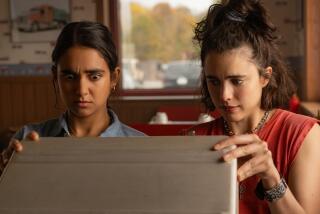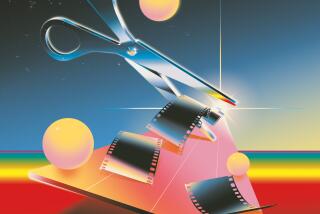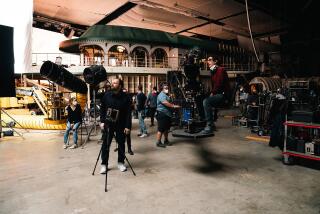The eye behind the camera tackles tracking shots, dramatic tension and submerged love
An erotic underwater love scene, the cheap but colorful motels of the displaced, a tennis match with more than a trophy at stake: Three cinematographers explain how they got their shots, and why they mattered.
Alexis Zabe | ‘The Florida Project’
The scene: Hailey (played by newcomer Bria Vinaite), a tattooed, twentysomething single mom raising her daughter in a cheap motel just blocks from Disney World, gets in a blowout argument with the gruff-but-sympathetic manager-handyman, Bobby (Willem Dafoe).
Shot significance: Co-written and directed by Sean Baker, “The Florida Project” showcases a population known as the “invisible homeless”: people who don’t live on the streets yet have no permanent homes. Bobby’s confrontation with Hailey highlights her economic uncertainty. The character has turned to prostitution to pay the rent and has gotten into trouble with Bobby for stealing from a customer.
Birth of the shot: Most of the episodic comedy-drama follows a trio of kids and was partially inspired by “The Little Rascals.” According to director of photography Zabe (whose résumé mostly consists of international independents and short films), the idea was to present the world through the children’s impressionable eyes. “Most of it was shot very low,” said Zabe. “There were a lot of up angles. You see the arms and legs of adults. We were remembering what the world seems like when you’re a 6- or 7-year-old. How colors are more vivid. Reality might be grimy, but to you, it might still be beautiful.” The argument scene, however, was one of the relatively few sequences plotted solely around adults — and one of the most complicated to film.
Making it work: Baker famously shot his last feature, “Tangerine” (2015), on an iPhone and insisted on shooting “The Florida Project” in 35mm to achieve a “softer feel than digital,” according to Zabe. The argument scene begins outside a third-floor hotel room, continues with Vinaite and Dafoe trading verbal barbs while making their way down an outdoor stairwell, and concludes in the motel lobby; a sequence captured by Steadicam in one continuous, tracking shot.
“There might be one edit,” noted Zabe. “Just for dramatic purposes, we wanted to keep it going. They walk all the way down, covering a lot of real estate. And it ends with her awkwardly sticking a feminine hygiene product on the window of the lobby.”
He adds: “It’s always fun to shoot these long, complicated scenes.”
Linus Sandgren | ‘Battle of the Sexes’
WATCH: Video Q&A’s from this season’s hottest contenders »
The scene: Emma Stone and Steve Carell face off on the tennis court in the 1973-set biographical drama’s climactic, winner-take-all exhibition match-cum-nationally televised media circus.
Shot significance: Respectively portraying women’s champion Billie Jean King and self-proclaimed male chauvinist pig Bobby Riggs, the two players battle for bragging rights despite their gender difference and 26-year age gap. But what’s really at stake is a demand for respect by female tennis players, who earned significantly less than their male counterparts on the pro circuit at the time — as well as for women in society in general.
Birth of the shot: Sandgren, winner of this year’s cinematography Oscar for “La La Land,” along with co-directors Jonathan Dayton and Valerie Faris ( 2006’s “Little Miss Sunshine”), strenuously avoided ’70s nostalgia, opting instead to operate “like contemporary filmmakers from the ’70s,” the director of photography said. That involved shooting on 35mm film and processing the stock to maximize color contrast, saturation and grain. “I also really liked to capture the image in camera as much as possible,” Sandgren said. “Inspiration came from the look of films of the ’70s, like ‘The Parallax View.’”
Making it work: Lookalike professional tennis players served as stand-ins for Carell and Stone, re-enacting crucial moments in exacting detail (before undergoing “face replacement” during post-production). “It was very important for Jon and Valerie to have the ‘Battle of the Sexes’ match be as authentic as possible to the real match,” noted Sandgren. “Therefore, they choreographed every point.”
Also important: filming the tennis like an actual sporting event rather than an action movie. “There’s a reason why tennis matches are shot the way they’re shot. You have to understand what’s going on,” the cinematographer said. “We watched other tennis movies from 10, 15 years ago. They just looked stupid — if you follow the tennis ball with a cable cam or something. Steve and Emma were also playing the points. But we’d only go to close-up for everything that went on in between. It was much more about the emotion and tension in the game.”
Dan Laustsen | ‘The Shape of Water’
The scene: A mute cleaning lady at a secret government research facility (Sally Hawkins) and an amphibian humanoid creature (Doug Jones) consummate their cross-species romantic feelings for one another in an apartment bathroom that’s been flooded to the ceiling with water.
Shot significance: Co-written and directed by Mexican filmmaker Guillermo del Toro, “The Shape of Water” straddles multiple genres: fantasy, period drama, romance, even musical. Arriving about two-thirds of the way through the movie, the bathroom love scene features full-frontal nudity from both actors (Jones’ by way of a meticulously designed costume) and is both shockingly erotic and gorgeous despite its genre trappings.
Birth of the shot: According to Danish cinematographer Laustsen, who previously served as Del Toro’s director of photography on 2015’s “Crimson Peak” and 1997’s “Mimic,” plans for the scene were carefully laid out during pre- production with discussions centering on whether it should be shot in a swimming pool or a tank on a sound stage. Del Toro had precise ideas about how light should come in through the bathroom window — and how fluorescent lights over the mirror would need to be waterproofed. “In the end, we decided to build a very small tank in the studio just a little bit bigger than the bathroom,” Laustsen said.
Making it work: The scene was shot on digital video inside a 10-foot-high tank in Hamilton, Canada, with the actors submerged for three-quarters of a day. Most of what arrives on-screen was captured in-camera with Jones performing underwater in his costume and minimal “DI” (as digital intermediate processing is known) of colors during post-production. “The fish man was in the suit, a latex suit, all the time,” Laustsen said with a laugh. “It’s so beautiful, and that guy is so powerful, you can fall in love with him.”
More to Read
From the Oscars to the Emmys.
Get the Envelope newsletter for exclusive awards season coverage, behind-the-scenes stories from the Envelope podcast and columnist Glenn Whipp’s must-read analysis.
You may occasionally receive promotional content from the Los Angeles Times.







